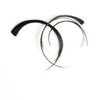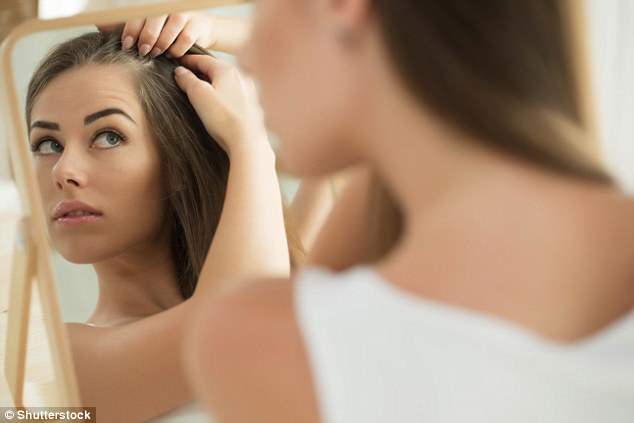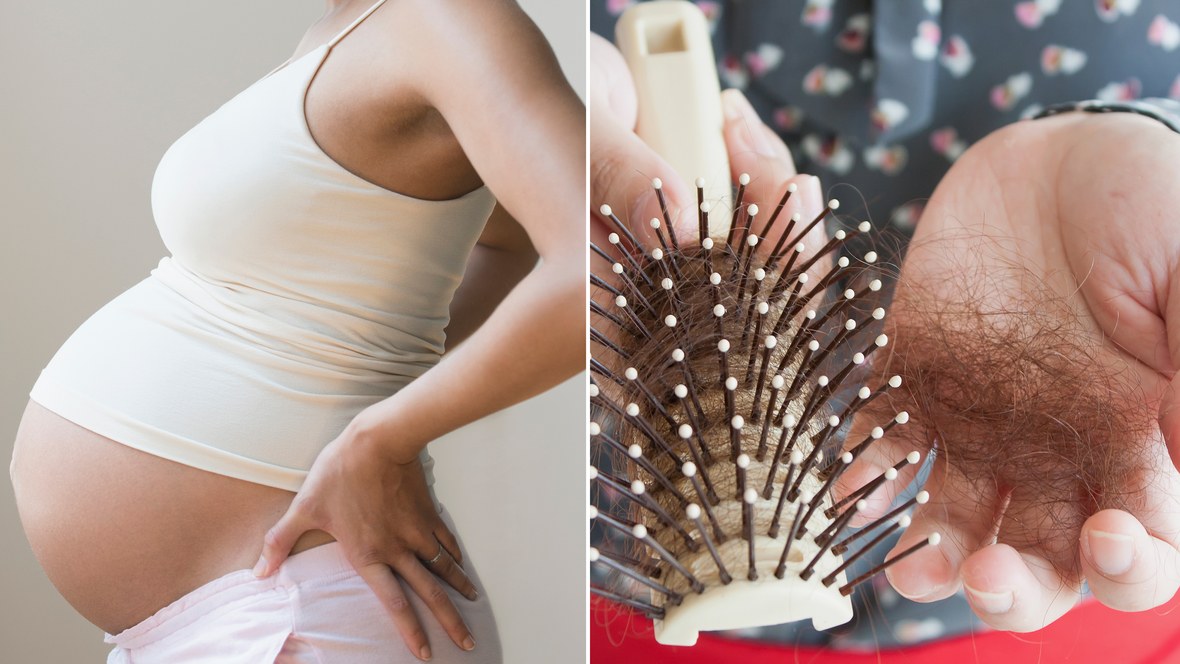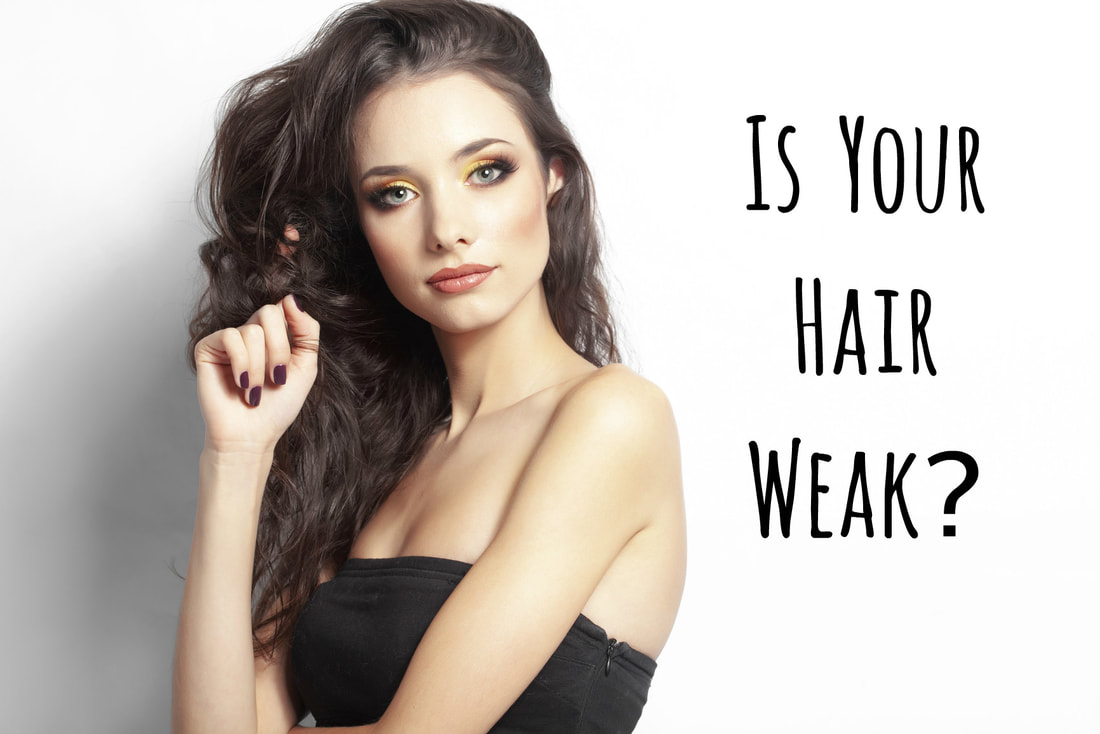|
5/12/2018 Eat Your Way to a Healthy Head of HairScalp expert reveals the secrets to regaining fuller locks - and it all starts with six essential nutrients
They say we are what we eat. But not eating enough nutrients can lead to dry scalp, brittle locks or even hair loss. Australian trichologist Simone Lee said the secret to growing healthy hair all starts with your diet. She revealed the six essential nutrients - proteins, carbohydrates, fats, vitamins, minerals and water - to help strengthen hair tissue and promote growth. Here, she shared the foods that contain the right nutrients for healthy hair. Nutrition is the interrelation between organisms in the body and nutrients that have been transformed from digested food and ingested by the body's organisms,' Ms Lee said. 'A failing in the conversion and absorption of nutrients from food will affect the cellular activity within the body and ultimately can result in the occurrence of disease, unhealthy hair and even hair loss. 'Consuming appropriate amounts of the six essential nutrients is the key to growing healthy Hair.' PROTEINS Hair is made up of protein so if you are not eating enough protein, this would subsequently cause hair loss. There are four key amino acids necessary to produce hair keratin - cysteine, lysine, arginine and methionine. 'Of these amino acids lysine and methionine are classified as essential, meaning they are not formed by the body and must be made available through our diets,' she said. She explained you can also top up your intake of protein by eating lean meats such as chicken, fish, beef, pork or lamb - or dairy products such as eggs, milk, cheese and yoghurt. 'Consuming combinations of vegetables that are high in proteins like peas, beans and soya beans are a great way to boost protein levels within the body,' she said. CARBOHYDRATES 'Carbohydrates are essential for a well-balanced diet. When the carbon system unites with oxygen in the blood stream, immediate calories used for energy by the body are produced,' Ms Lee said.
'This energy helps divide the cells in the hair matrix and germinating layers of the skin. Carbohydrates help regulate protein and fat metabolism.' Simple carbs or sugars can be found in natural foods including fruits, honey, milk and vegetables. 'Some great sources of complex carbohydrates are beans, lentils, peas, whole grains and starchy potatoes,' she said. FATS 'Maintaining body functions is assisted by a healthy intake of fats,' she said. 'Vitamins must have fat to dissolve and nourish the body. and polyunsaturated fats help keep hair shiny. 'Fatty acids essential such as linoleic (Omega 6) and Linolenic acid assist in inadequate oil production from the sebaceous gland. Omega 3 can be activated in the body through consumption of linseed and marine oils from salmon, tuna and sardines. Deficiencies in magnesium, zinc and vitamin b6 may result in inhibited Omega 3 and Omega 6 pathways within the body which can cause hair loss. VITAMINS Fresh fruit, green vegetables and grains are a great source of water soluble vitamins. Vitamins connected to maintaining healthy hair and scalp are: Vitamin A - helps prevent dry hair, and maintaining a healthy skin. Found in carrots, liver and green vegetables. Vitamin B (thiamine) - assists in prevention of dandruff and red skin. Found in liver kidneys and green vegetables. Vitamin B (pantothenic acid) - Helps maintain hair colour and possibly prevent early greying. Found in mushrooms and liver. Vitamin B (folic acid) - Required for cell multiplication. Found in liver, kidneys and green vegetables. Biotin - Water soluble B vitamin, lack of biotin can cause brittle hair. Found in wholegrains, liver and yolk. Vitamin C - is needed for maintaining skin health. Found in citrus fruits. Vitamin D - assists in the absorption of calcium and food digestion. Found in eggs, fish and milk. Vitamin E - aids in hair growth, blood circulation and may help premature ageing of skin. Found in eggs, green vegetables and bread. Vitamin K - assists in the prevention of blood clotting, aids blood circulation. Found in broccoli, Brussels sprouts and cabbage. MINERALS Minerals are chemicals the body requires in order to work properly. They are equally as essential as vitamins and also can be obtained from food. Minerals connected to maintaining healthy hair and scalp are: Cobalt deficiency leads to scaly dry skin. Found in broccoli and fruit. Copper deficiency may cause hair loss and greying. Found in liver, cereals and nuts. Iodine deficiency may cause thinning of hair and dry hair. Found in shellfish, kelp and other seafood. Iron helps prevent brittle hair and maintain a healthy hair growth cycle. Found in liver, egg yolk and puha. Zinc deficiency may lead to hair loss, dry and oily skin. Found in oysters, wheatgerm and bran. WATER 'An appropriate consumption of water is essential for life. Two thirds of our skin tissues are made up of water,' she said. 'The human body loses approximately two litres of body fluids in a day, and is replaced through consumption of water and other liquids.' By going through litres of mineral water every day, it will hydrate your hair and prevent dry scalps. This article first appeared on DailyMail 4/29/2018 These are the Best Oils for Scalp HealthThe secret to healthy hair begins at the root. Maintaining a clean, moisturized and healthy scalp leads to healthy hair and hair growth. If your scalp is itchy, irritated, or dry your curls will pay the price which can lead to hair breakage. In order to create a healthy hair regimen, you can revitalize your scalp with the use of oils. Here are 4 of the best oils for scalp-care to use when you just can't stand the itch.
1. Lavender This is one of the most obvious oil choices. Lavender is naturally antibacterial, so it can help cleanse the scalp of bacteria, fungus, and other gross things that go on there. It also smells great and can give a nice calming effect. The main reason people choose this oil is that it has been reported to help with hair growth. In fact, a study published in the journal, Toxicological Research, found that lavender oil increases hair growth. The Jamaican Mango & Lime Black Castor Oil Lavender is pure and unrefined, retaining all their nutritive properties making it great to use as a skin softener, moisturizing massage oil or as a hot oil treatment for dry damaged hair, hair growth, and thinning hair. 2. Peppermint When looking at the best oils for scalp health, peppermint oil is a no-brainer. This oil gives cool, tingling sensations that many people enjoy. While the feeling itself is pleasant, the effects of the tingle are an increase in circulation. Without proper circulation of blood, the scalp has a hard time generating new growth and turning over cell regeneration. Again, much like lavender oil, studies have confirmed that peppermint oil has benefits in the area of hair growth. Studies published in Toxicological Research indicate peppermint oil helps with hair growth by extending the anagen phase of the hair growth process. Eden Bodyworks Peppermint Tea Tree Hair Oil is an exotic blend of nourishing ingredients that penetrate the hair from root to tip to promote new hair growth without clogging pores. A perfect choice for hot oil treatments on all hair types. 3. Horsetail One of the rare plants that can be used as an oil and an oral supplement, horsetail is rich in silica. Silica helps hair to grow, as well as helps to improve the strength of your curly strands. A study published in Dermatology Research and Practice reports that taking horsetail oil supplements can decrease hair shedding for women with thinning hair. There is also evidence to suggest that topical applications of the oil can have similar effects. Alikay Naturals Essential 17 Hair Growth Oil is blended with 17 of the best natural oils such as the horsetail powder which is extracted from the plant to reduce dandruff and hair loss. 4. Tea Tree Dandruff, dead cells, and bacteria can get in the way of a healthy scalp. With tea tree oil, your scalp gets a powerful clean to remove product build-up. A study published in Journal of American Academy of Dermatology found that the use of shampoo with even a small percentage of tea tree oil in the formula could cause a 41% improvement in reducing dandruff flakes. Tea tree oil is known to be the cure scalp issues and has so many amazing benefits such as being an antibacterial, antifungal, and helps with dandruff and hair loss. Do you use any of these oils to care for your scalp? Let me know which ones are your favorite the next time you're in the salon. This first appeared on NaturallyCruly 3/21/2018 How to Deal with After-Pregnancy HairA common question that new mothers ask, is whether or not hair loss is normal. We’re going to admit that a few months after you give birth, attempts to use your professional curling wand might end in disaster as it pulls out strands and leaves you wondering whether or not something is wrong with you. You’ll get the same result when you step into the shower, without a doubt. Not only will you get a clogged drain, you’ll get a head full of worry, and it’s definitely not pleasant. That being said, you probably want to know what’s going on, and it all has to do with the growth cycle during the pregnancy.
Hair growth cycles do last longer during pregnancy, and as a result, your hair gets thicker – this is a direct result of increased estrogen in the body, and it does increase the anagen phase of hair growth. Following pregnancy, the anagen phase returns to normal and your hair falls out, so ultimately, the question is, what can you do about it? Try Different Hairstyles along with a Professional Curling Wand There are quite a few things that you can do to address the hair issue, and once you first start to experience the problem, you’ll probably be attempting to compensate for the loss of volume. Use the following steps to fix your hair problems and get it back on the right track. Get a Haircut Is there ever a good reason to not get a good haircut? Seriously, any excuse to rush into the salon and take care of business is a good one. If you speak to your hairstylist, there is a good chance that you can get them to give you a haircut that helps to increase your volume while giving you a style that perfectly supports the condition post-pregnancy has left your hair in. Start Using Different Products If you were a huge fan of your hair during pregnancy then there is a chance that you want it to keep the same volume, and who can blame you? On many people, pregnancy hair is absolutely beautiful, and with that being the case, we would strongly recommend that you start using volumizing products in combination with your hair curler set or any other heat tools that you have on hand. Most importantly, when you decide to experiment with different products, we would strongly recommend that you use those of the highest possible quality. One of the biggest mistakes that we see people make is the purchase of cheaper products, even if they own professional curling sets. Let’s be clear: you don’t want to buy 50 cent shampoo at the dollar store. Instead, choose something that’s infused with argan oil and can give your hair the healthy shine it needs. It’s a bit more expensive, but you’re going to thank us at the end of the day. If you need any hints or tips on great products, make sure you take a look at our store, you’re going to be quite pleased with what we have to offer! Style it Properly There are many ways to maintain your volume, for example, if you are using a hair straightener, you can pull upward on your locks, rather than downward to create the illusion of additional volume. It’s a pretty simple trick but it works very well. Take Good Care of your Hair Just as with any other major change, this will put some stress on your body, and with that being the case, you do need to make sure you’re taking proper care of it. Use the right products and as per always, use the right protection with your hair wand set. Once your hair returns to normal you’ll have a lot to learn, again, but it won’t be too difficult. As always, make sure you check out our Carebox, which, for a fairly low price contains all of the products you need to make your hair sleek and shine every single month. This article first appeared on HSI Professional Being a new mom can be one of the most emotionally rewarding — and challenging — experiences a woman faces. And while you may have anticipated your body to go through a whirlwind of changes, you may not have expected your hair to start falling out in clumps. Also referred to as postpartum hair loss, telogen gravidarum, and telogen effluvium, excessive hair shedding after childbirth (which would occur anywhere between two and four months after giving birth) can affect between 40 and 50 percent of women, according to statistics from the American Pregnancy Association. “When a woman is pregnant, she has a lot of extra hormones in the body, including estrogen,” says Christine Carlan Greves, a board-certified obstetrician and gynecologist in Orlando, Florida. “The estrogen helps protect us from losing our hair. Then when she has the baby, there’s a sudden change in the hormone levels, including a drop in the estrogen. And this shift can cause a response in the body that may affect the hair cycle.” In fact, Greves adds that breastfeeding can also contribute to hair shedding because it increases prolactin levels (the hormone produced in the pituitary gland that is responsible for breast milk production), which is associated with hair loss as well. Margarita Lolis, a board-certified dermatologist who practices in New York and New Jersey, explains there are three different stages of hair growth: anagen (the growing stage), catagen (the intermediate period during the growing stage), and telogen (the resting or shedding stage). “In telogen effluvium, all the stages synchronize, so you’re seeing the hair fall off,” she states. While post-baby hair shedding cannot be prevented, the good news is that it’s a temporary condition that usually corrects itself by your little one’s first birthday. In the meantime, Lolis shares tips for promoting new growth and treating your hair with TLC during this sensitive time. Use a volumizing shampoo. These products tend to contain dimethicone, which is a silicone-based polymer. “This ingredient coats and seals the hair, which makes it look healthier and fuller,” she says. Condition the “light” way. Lolis suggests avoiding shampoos and conditioners labeled “conditioning” since these heavier products will weigh the hair down. “When you use conditioner, just condition the roots and not the scalp for the same reason,” she adds. Stimulate your scalp. She advises using Restorsea Revitalizing Scalp Treatment, which is made from an enzyme that a baby salmon releases at birth. “This spray helps clear all the dead skins around the hair follicles, helping the hair follicles to stay open.” Keep in mind, this product is only available through licensed physicians. Sport softer hairstyles. “Avoid pulling your hair back tightly because that traction can lead to hair loss,” notes Lolis. If you’re longing for an updo, use a bandana or scarfover your head. Consider supplementing. While biotin seems to get most of the attention, Lolis recommends the hair supplement Nutrafol. “It contains enzymes that are naturally found in the body, which help to promote hair growth,” she explains. This article first appeared on Allure Shocking footage of stylist pulling out huge clumps of a client's locks reveals the true extent of post-natal hair loss Read more: http://www.dailymail.co.uk/femail/article-5152277/New-mother-shares-shocking-video-postpartum-hair-loss.html#ixzz58EknLFTG 3/16/2018 8 Tips on How to Strengthen Weak HairWeak hair can take on many forms and is often noticeable to others. That said, weak hair can be a detriment to our fashion sense and self image. In some cases, it can even be an indicator of a medical concern. Not sure about your hair’s health and what to do about it? The pros at Matrix are here to give you a few tips on how to make weak hair stronger.Diagnosing Weak Hair
Weak hair can be defined as limp, droopy, thin or falling out. Split ends, extreme dryness or excessive oiliness can all be signs of weak hair. It is often genetic, handed down from a parent, or it can be caused by hormonal factors such as menopause or childbirth, birth control pills or other medications, disease or illness, poor diet, stress, a fungal infection of the scalp or cancer treatments. Environmental impact from sun exposure, chlorine or salt water, air conditioning or heating and pollution can weaken hair. It is normal to lose 100 to 150 hairs each day, but since most people have about 100,000 hairs on the head, this loss is not significant. When a hair is lost, a new one grows back in its place. This process continues until middle age, when hair re-growth slows down or stops. Hair that is lost from breakage is not the same as normal loss. Hair that falls out naturally comes from the scalp, typically with the bulb attached. Breakage from weakness is when the hair breaks off below the scalp. While some breakage is normal, excessive breakage indicates weakened hair. Weak hair often shows itself as split ends, which can travel up the hair shaft and break off. 1. Use the Right Products to Avoid Further Damage to Weak Hair A good stylist can help you detect and diagnose weak hair, and make recommendations on appropriate product usage. Using the best products for weak hair is essential to restoring troubled tresses. For weak, delicate hair, use a shampoo, conditioner and styling products that will reinforce the hair by infusing protein, amino acids and other strengthening properties. Don’t use a shampoo that will dry out hair, and when using a reinforcing conditioner, start at the roots and work the conditioner through to the ends. You can enhance conditioning by wrapping a hot towel or shower cap over your head to allow it to penetrate deeply into the hair follicles and shafts. A protein mask or deep conditioning treatment can also be beneficial to locks that have lost their strength. Keep in mind, however, that the products we use on our hair can be overdone. You can have too much of a good thing, and excessive product usage over time causes damaged and weak hair. When hair is already damaged, compensating with more product can weigh it down, making weak hair look dull and rough. Avoid styling products that contain alcohol, for example, which can be drying to hair; and try to limit shampooing to every other day or even less frequently if your scalp doesn’t produce too much oil. 2. Take Care of Weak Hair by Limiting Chemical Use Abusing and over-processing hair can lead to weak tresses. Ongoing use of strong chemicals through coloring, bleaching, straightening or permanents can damage hair fiber and make hair weak. When used too frequently or in too strong a dose, these chemicals can cause permanent damage, making weak hair dry and frizzy, with split ends and breakage the result. Counteract chemical warfare by using a shampoo and conditioner for damaged hair and intensive conditioning treatments. Look for styling products containing stearyl alcohol, a fatty alcohol that helps strengthen and soften weak hair. For severely weakened hair, use a deep-conditioning protein treatment once a week or so. Apply the treatment all over hair that has been cleansed with a hydrating shampoo and leave it on overnight (wrap hair into a bun and sleep with a towel on your pillow). Rinse the treatment out in the morning. When you do opt for haircolor, ask your stylist about conditioner-rich and ammonia-free professional formulas. 3. Weak Hair Hates Heat: Don’t Play With Fire Excessive heat from blow-dryers, hot curlers, curling irons and flat irons can cause weak hair and breakage. Using a too-hot blow-dryer on wet hair heats the water remaining under the hair’s cuticle and causes it to expand inside the hair, leaving spaces--or blisters --inside fibers, which weakens hair. These parched strands soak up moisture from the air, causing frizz. Rather than fighting your natural texture, work with what you’ve got. For straight hair, enhance its health and shine by using cleansing and conditioning products specifically designed to create shine. For curly hair, use products created for wavy texture and scrunch the hair with your fingers to reduce frizz. To nurse fried strands back to optimum health, use a hydrating shampoo and conditioner, then fortify with a strengthening product prior to styling. Keep styling tools set on low temps, apply heat protection products before styling with dryers or irons to protect from thermal damage and follow with finishing products that are infused with protective oils. 4. Strengthen Weak Hair by Switching Up Your Style Change how you wear your hair every day: Wearing your hair down day after day can result in tangles and split ends. But ponytails, tight braids and dreadlocks can also stress tresses and cause weakening. Switch styles every day to avoid strain on weak hair and give your look a pick-me-up. When wearing hair down, use a strengthening shampoo, conditioner and styling products to protect weak hair. When wearing it up, use fortifying gel or mousse and hair-protecting elastics with no metal on them. The friction of over brushing and wearing tight-fitting hats can also cause hair to weaken. Don’t get too zealous when brushing, and never brush wet hair. It’s best to use padded brushes and those with animal hair bristles on delicate locks. A good detangling spray will help defend weak hair while brushing. Spritz it on before combing through wet hair to ease strand stress. 5. The Frizz Factor, and How To Prevent Frizz When frizziness is apparent, keeping hair trimmed can help prevent further damage and stop the splits from traveling up the hair shaft. Using a keratin shampoo and conditioner can help restore protein to weak, damaged hair and help bring it back to good health. But remember, this won’t happen overnight; you’ll need to use it regularly to notice a difference. After shampooing, there are a variety of weak hair serums and leave-in conditioners available to help tame frizz. When using oil-based serums, avoid putting them directly on your scalp, as it can become greasy and make the roots look oily. When styling, choose finishing products that enhance smoothness and shine. 6. How To Treat Split-Ends: A Hair Divided is Not Happy and Healthy There is no total cure for split ends, but as mentioned above, you can keep them at bay with a trim every six to eight weeks. For more temporary remedies, use a gentle shampoo and conditioner, and apply a treatment oil to just the tips of tresses. When styling, reinforcing products are best, as they help bond the ends together. 7. How To Care For Your Scalp: Hair Health Starts at the Top When working to heal weak hair, the first line of defense is to start with the scalp. If your scalp is healthy, your hair will follow suit. Scalps can be dry and flaky or oily, but there are products designed to work with each type. For dry scalps that feel tight or itchy, a moisturizing oil can be massaged into the scalp for five minutes before showering. A hair mask or deep conditioning treatment will help provide moisture to dry scalps and weak hair. If your head is itchy and you are regularly finding flakes on your shoulders, you may have dandruff. Nothing kills a good look quicker than a shoulder covered in scalp snow, so if dandruff is a problem, research the variety of dandruff shampoos, conditioners and treatments on the market, or get a recommendation from your stylist or medical provider. 8. A Healthy Diet Helps Restore Weak Hair Weak and thinning hair can be caused by what you do to your hair, but it can also be brought on by what you do to your body. An unhealthy diet, or too-low of a caloric intake (crash diet), can lead to hair falling out, as can endocrine disorders. What you eat has an effect on the health of your hair and scalp. The nutrients from healthy food provide the energy that fuels hair growth. A diet that includes iron-rich protein feeds your scalp and hair by building strong keratin, the protein that strengthens hair, improves texture and stimulates growth. Consume lean meat, fish, low-fat cheeses, egg whites, spinach and soy to keep your head happy in more ways than one. In between meals, snack on fruits, vegetables and grains. Vitamins are also key to hair health. Vitamin C, or collagen, keeps blood vessels in the scalp healthy by supporting hair follicles. Vitamin C also helps you absorb iron from plant proteins. Biotin, an essential B vitamin, strengthens weak hair and improves its texture. Biotin is found in salmon, carrots, egg yolks and sardines. Vitamin supplements can help weak hair as well. Silica, a nutrient found in oats, rice, cucumbers, asparagus, cabbage and sunflower seeds, supports growth of hair and nails, as does calcium, found in dairy products, fish and leafy greens. Water is another essential for your body and your hair. Adequate hydration helps keep your body functioning like a well-oiled machine, and helps strengthen weak hair. It’s best to drink plenty of water throughout the day and evening. If the hair care tips listed in this article don’t help make your weak hair stronger and thicker, pay a visit to your doctor or dermatologist to rule out a medical condition. This article first appeared on Matrix.com |
Hair by BrianMy name is Brian and I help people confidently take on the world. CategoriesAll Advice Announcement Awards Balayage Barbering Beach Waves Beauty News Book Now Brazilian Treatment Clients Cool Facts COVID 19 Health COVID 19 Update Curlies EGift Card Films Follically Challenged Gossip Grooming Hair Care Haircolor Haircut Hair Facts Hair History Hair Loss Hair Styling Hair Tips Hair Tools Health Health And Safety Healthy Hair Highlights Holidays Humor Mens Hair Men's Long Hair Newsletter Ombre Policies Procedures Press Release Previous Blog Privacy Policy Product Knowledge Product Reviews Promotions Read Your Labels Recommendations Reviews Scalp Health Science Services Smoothing Treatments Social Media Summer Hair Tips Textured Hair Thinning Hair Travel Tips Trending Wellness Womens Hair Archives
June 2025
|
|
Hey...
Your Mom Called! Book today! |
Sunday: 11am-5pm
Monday: 11am-6pm Tuesday: 10am - 6pm Wednesday: 10am - 6pm Thursday: By Appointment Friday: By Appointment Saturday: By Appointment |








 RSS Feed
RSS Feed